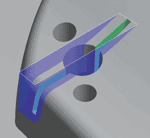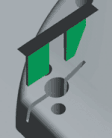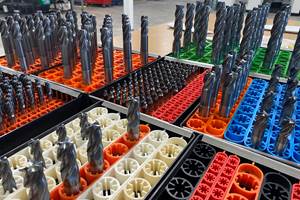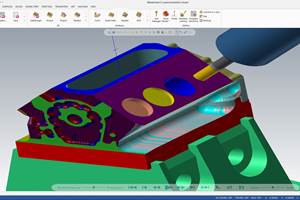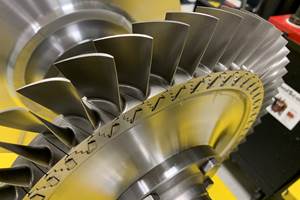Automating EDM Electrode Design For Mold Making
Many EDM electrode design steps are being automated, making electrode production faster and easier. Developments promise to streamline situations where EDMing is unavoidable, as well as make EDM attractive as the most efficient machining process in many cases where complex mold shapes are involved.
For decades, die/mold work has been a stronghold for ram-type electrical discharge machines. In fact, these machines are often referred to as diesinkers or sinker EDMs. But lately, there has been a trend away from EDM in favor of high speed machining and hard milling techniques. The advantage to these alternative processes has been the elimination of electrode production. Electrical discharge machining has always required the machining of a shaped electrode in copper or graphite. This is an added step imposed by the EDM process and is often a bottleneck. And before an electrode can be machined, numerous steps have to be completed by designers and NC programmers.
Now, many of those steps are being automated, making electrode production faster and easier. This development promises to streamline situations where EDMing is unavoidable. It also helps make EDM attractive as the most efficient machining process in many cases where complex mold shapes are involved.
Cimatron Limited, a CAD/CAM company primarily focused on software products for the die/mold industry, has introduced a CAD/CAM application package for automating the electrode process, called QuickElectrode. QuickElectrode can be used for burn area selection, electrode design, management, documentation and manufacture of solid or surface geometry. This software is designed to
- provide fast and accurate methods to identify burn areas,
- associatively extract burn areas from the workpiece,
- manipulate the burn area geometry to design the electrode,
- utilize standard libraries for blank, base, and holder sizes,
- automate electrode manufacturing, and
- automate electrode documentation.
According to the company, such a system must have analysis capabilities for the burn area selection, top-down assembly capabilities for extraction, advanced surface creation/modification tools for electrode design, bottom-up assembly capabilities for blanks, bases, and holders, high-end NC programming capabilities for electrode machining, and integrated detailing and drafting to document the EDM process. In short, the system must be capable of providing both CAD, CAM and drafting in a fully associative single database to meet this challenge.
Key features of QuickElectrode include:
- Burn area definition utilizing a dynamic drag and auto-extract technique.
- Selection of blank shapes and sizes from a standards list.
- “Fit Blank” and “Center Blank” functions that determine best-suited blank size with operator control of values.
- Dynamic clearance plane positioning to eliminate collisions between the electrode holder and the workpiece.
- A slide bar function that moves the electrode in and out of the core being burned, to check geometry and clearances visually on the screen display.
- Control over the display and activation of a single or group of electrodes, while allowing several users to work collaboratively on the same part.
- Electrode design modification tools to enable multi-surface tangent and linear extensions of burn area boundaries.
- Wizard-based construction of electrode blank and base with optional shape, size and location from standard library.
- Report generation that automatically creates setup sheets, burn locations and electrode schedule.
- Wizard-based automatic tool pathing for electrode machining.
Mold buyers are demanding shorter and shorter lead times to get their products to market. Process automation offers the most direct method of reducing lead times for mold making. Much has been written about how to effectively enhance ram EDM through spark efficiency, pulsing techniques, flushing methods, adaptive controls, dielectric fluids, and powder suspended fluids. Often overlooked is the impact that CAD/CAM can have on the electrode design and manufacturing process. Developments in this area may do more to swing the pendulum back to greater use of EDM than any improvement in the EDM process itself. MMS
Related Content
Finally, A Comprehensive Software Solution Designed for Small Job Shops
Zel X from Siemens is an integrated software application that consolidates collaboration, design, manufacturing, and operations into a comprehensive, easy-to-use solution. From RFQ to delivery, it’s a more efficient way to handle quotes, manage jobs, make parts, and collaborate with teams of all sizes.
Read MoreGrinding Simulation Enables Growth in Custom Tooling
Simulation software both streamlines Gorilla Mill's grinding machine setups and speeds up the company's tooling design and verification processes.
Read MoreCAD/CAM System Requirements: An Overview
CAD/CAM programs are among the most demanding kinds of computer software. Smooth operation requires careful consideration of computer specifications.
Read MoreIntegrated CAD/CAM Promotes Process Efficiency, Traceability
High-requirement markets are not only searching for good parts — they're searching for proof of good parts. CAD/CAM software can help.
Read MoreRead Next
3 Mistakes That Cause CNC Programs to Fail
Despite enhancements to manufacturing technology, there are still issues today that can cause programs to fail. These failures can cause lost time, scrapped parts, damaged machines and even injured operators.
Read MoreThe Cut Scene: The Finer Details of Large-Format Machining
Small details and features can have an outsized impact on large parts, such as Barbco’s collapsible utility drill head.
Read More





